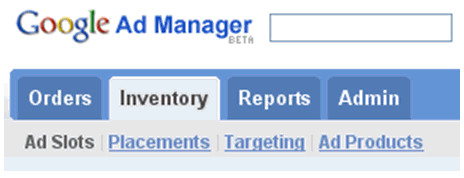 Google Ad Manager has been designed to serve and track the performance of both directly sold ad units sold as well as those arriving from third-party networks you may be associated with.
What ad management problems is Google Ad Manager designed to solve? According to Google these that follow are the typical
Google Ad Manager has been designed to serve and track the performance of both directly sold ad units sold as well as those arriving from third-party networks you may be associated with.
What ad management problems is Google Ad Manager designed to solve? According to Google these that follow are the typical
- Confusing, slow, and complicated sales and trafficking workflows
- Inflexible site tagging
- Uncertainty about which ad source to deliver to optimize yield
- Unreliable inventory forecasting
- High ad-serving costs
- A clear user interface: Increase your staff's efficiency and productivity.
- Simplified tagging: Tag your site only once.
- Yield optimization: Automatically maximize your CPMs.
- Reliable inventory forecasting: Always know what inventory is available to sell.
- Higher ROI: Save costs, because Google Ad Manager is free.
- Operate a large website with reserved and remnant ad inventory.
- Sell your ad inventory directly to advertisers (or plan to sell directly to advertisers in the future).
- Want to improve the efficiency of the sales process and feel confident in your forecasting.
- Need a consistent way to deliver ads that make you the most money.
- Find that some of your inventory always remains unsold because you couldn't accurately forecast availability.
- Inventory Management
- Yield Optimization
- Ad Targeting
- Trafficking, Ad Delivery, and Order Booking
- Creatives and Rich Media Management
- Reporting
- User Interface
- Administration

Google Ad Manager Overview
Google Ad Manager is a hosted ad serving and management service for small business publishers. Google Ad Manager key purpose is to help web publishers manage and optimize ad inventory in the best possible way by centralizing in one tool everything you need to schedule, enable, measure and delivery ad campaigns for your web site(s). Furthermore, the Google Ad Manager fully integrates with your existing AdSense account in order to fully optimize unsold advertising inventory. In Google's own words:"Ad Manager can help you sell, schedule, deliver, and measure both directly-sold and network-based inventory. It offers an intuitive and simple user interface, Google serving speed and reliability, and significant cost savings. Best of all, Ad Manager can be optionally integrated with Google AdSense to offer you an automated way to maximize the revenue of your unsold and network-managed inventory." (Source: Google)One thing to note is that Google Ad Manager is strikingly similar to OpenX, an open-source ad manager software which has been available since over a year. But while the Google Ad Manager runs on Google own servers, OpenX requires installation of its software on your own server. One may also consider looking at Google Ad Manager as an effective complement to the Google-DoubleClick Revenue Center and to DART for Publishers, which have been marketed mostly to sites with large advertising sales forces, as it provides new and complementary opportunities for increasing ad revenue for all online media publishers.
Google Ad Manager - Key Features
Google Ad Manager integrates a long list of excellent ad management, targeting and serving features. Here is a detailed features list to give you a better idea of the depth and scope of this new Google web service:1) Inventory Management
- Ad Network Management: Easily manage your third-party ad networks in Ad Manager to automatically maximize your network driven revenue.
- Inventory Levels: Define inventory at granular levels for more efficient line item creation and trafficking. Use ad slots to generate Ad Manager tags for your pages, ad placements to group related ad slots, and ad products to bundle and sell inventory packages with the same cost and targeting criteria.
- Inventory Availability Tracking: Easily confirm whether ad impressions are available for specific dates, placements, and targeting criteria. Avoid overbooking and underselling.
- Simple Ad Tag Generation and Management: Copy and paste tags directly into your HTML. Avoid the need to re-tag your site when you change the way you sell your inventory. (Available upon request: iframe tags.)
2) Yield Optimization
- Optional AdSense Integration: Use AdSense to fill unsold inventory or compete on price against other ad networks.
3) Ad Targeting
- Day and Time Targeting: Don't want your orders to run on weekends? No problem. With day and time targeting, you can set any new line items you create to run only during specific hours or days, or as little as 15 minutes per week. Use day and time targeting in addition to geography, bandwidth, browser, user language, operating system, domain and custom targeting.
- Built-in Targeting Options: Target ads to your site visitors' geography, day and time, bandwidth, browser, browser language, operating system, and domain.
- Customizable Targeting Criteria: Target ad impressions by passing your own custom key-value pairs to Ad Manager.
4) Trafficking, Ad Delivery, and Order Booking
- Delivery Options: Choose one of five delivery types (exclusive, premium, standard, remnant, or house) to determine, automatically, how ads may be delivered.
- Frequency Capping: Set multiple levels of frequency capping, which limit the number of ads the same visitor sees over a minute, hour, day, week, month, or lifetime.
- Roadblocking: Deliver multiple creatives together on the same page.
- Proven Google Infrastructure: Enjoy fast, reliable ad delivery and load time.
- Support for Various Ad Pricing Models: Choose from cost-per-thousand-impressions (CPM), cost-per-click (CPC), and cost-per-day (CPD).
- AdSense Integration (optional): Consistently deliver the highest-paying ad by enabling AdSense.
- Ad Network Management: Easily manage your third-party ad networks with network orders.
5) Creatives and Rich Media Management
- Rich Media Support: Use tags from a variety of rich media providers. Automatically detect macros.
- Free Ad Creatives Hosting: Save bandwidth and costs.
- Redirect Creatives Support: Easily track ads from a third-party network, affiliate provider, or other URL you provide.
6) Reporting
- Multiple Reporting Options: Run reports on order delivery, inventory performance, or overall sales.
- Detailed Reporting: Break down reports by date, line item, placement, advertiser, and other categories.
- Fast Report Generation: Create reports in seconds.
- Interactive Views: Sort data, add or remove columns, review different data subsets, and make other edits without having to leave the page or run a new report.
- Media Rating Council (MRC) accredited: Feel confident in Google Ad Manager's ad impression measurement process, accredited by the Media Rating Council to be fully compliant with Interactive Advertising Bureau standards.
7) User Interface
- Creative Preview on Live Site: Preview the look and feel of ads on your live site to ensure ads look as expected before you start the campaign.
- Search Functionality: Locate order, inventory, or advertiser data from any page in Ad Manager.
- Intuitive Workflows: Quickly and easily create orders, approve orders, and review status of orders. Decrease training time and trafficking steps.
- AdSense Channels Integration: Import your existing AdSense channels into Ad Manager (optional).
- Browser Session Support: Use your browser's 'Back' button and other built-in navigation without losing data.
8) Administration
- Access Controls: Set various viewing and editing permissions for your team.
- Contacts Organization: Store and manage advertiser and agency company information.
- International Language and Currency Support: Use Google Ad Manager in your native language and currency. Interface available in 32 languages.
- Automatic Macro Insertion: Save time and avoid tagging errors since Ad Manager now automatically detects and inserts macros from most popular 3rd party vendors.
How To Get Started with Google Ad Manager
 If you’re already an AdSense web publisher all you need to do is to sign up for Google Ad Manager here. If you’re not an AdSense publisher - you will need to sign up for a Google AdSense account first.
If you have an AdSense account, you can sign in to Ad Manager today. A Google AdSense account is a technical requirement for creating an Ad Manager account.
When you create a Google Ad Manager account, this is automatically linked to your AdSense account. The two can be fully integrated so that AdSense can be enabled to serve ads to some of your unused online unsold advertising inventory.
In my initial tests Google Ad Manager appeared to be relatively easy to setup and use.
Once you have defined your own campaigns and selected ad networks, you can automatically backfill empty ad slots with AdSense ads.
If you’re already an AdSense web publisher all you need to do is to sign up for Google Ad Manager here. If you’re not an AdSense publisher - you will need to sign up for a Google AdSense account first.
If you have an AdSense account, you can sign in to Ad Manager today. A Google AdSense account is a technical requirement for creating an Ad Manager account.
When you create a Google Ad Manager account, this is automatically linked to your AdSense account. The two can be fully integrated so that AdSense can be enabled to serve ads to some of your unused online unsold advertising inventory.
In my initial tests Google Ad Manager appeared to be relatively easy to setup and use.
Once you have defined your own campaigns and selected ad networks, you can automatically backfill empty ad slots with AdSense ads.
Editor's Comments
For those having a hard time maximizing their sites’ ad inventory, Google Ad Manager provides a very cost-effective (read free) solution to maximize your online ad revenue on existing small and medium-sized web sites. In essence, the Google hosted Ad Manager is a very useful tool to sell, schedule, deliver and measure directly sold and network-based ad inventory. The Ad Manager offers up a simple ad management interface and an effective ad serving and inventory management facility for serious web publishers. Darren Rowser at Problogger reports:"Ad Manager is going to be most useful to bloggers who have a decent amount of traffic and who are wanting to start selling ad placements directly to advertisers. If you’re still at the stage of just running AdSense on your blog then this will probably something you’ll want to grow into. It is reasonably easy to use and set up however unless you’re wanting to sell your own ads there isn’t much point."
Learn More
Get started with using Google Ad Manager. Full list of Google Ad Manager features. Read about Google Ad Manager success stories.Originally written by Robin Good for MasterNewMedia and first published August 27th 2008 as "Online Ad Management And Optimization: The Google Ad Manager Is Here"

